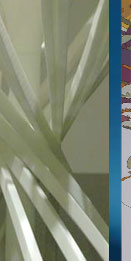エマージングテクノロジー「適応」
| 場所:ホール A | 開催時間 |
| 2009年12月17日(木) | 09:30 - 18:30 |
| 2009年12月18日(金) | 09:30 - 18:30 |
| 2009年12月19日(土) | 09:30 - 17:00 |
現実の社会に存在する課題とそれに取り込む機会について考える―今存在するものを将来存在するかもしれないものに適応させることにおいて、アートとテクノロジーの飛躍的な成果が見られます。世界が急速に進化する今、アーチストや研究者にその最前線を見せてもらいましょう。
シーグラフアジア2009のアートギャラリーとエマージングテクノロジーの展示は「適応」をテーマとしています。エマージングテクノロジーへの参加者は、最先端のデジタルメディア技術を駆使して、社会環境 に適応するためにどのように進化しているのかを 体験することができます。 下記が作品一覧となります
Lumarca

Lumarca (latin for "light box") is a truly volumetric display that allows viewers to see three-dimensional images. The system requires only a computer, a projector, and common materials found at most hardware stores. It is an attempt to put the power of true volumetric display in the hands of do-it-yourself artists. With the advent of the motion picture, flat representations became dynamic and able to simulate motion for the human eye. Over time, through films, television, and animation, the range of dynamic two-dimensional content has expanded, but there has been much less progress in production of dynamic three-dimensional content. Because it is simulated content rendered on a flat screen, the image does not change as the viewer's position changes. Perspective is set by a virtual camera inside the program, and perspective changes only when the camera is moved. And multiple viewers share the same perspective, even though they are not in the same position relative to the image. Displays that allow for different perspectives of the same virtual image in three dimensions are known as "volumetric displays". Recent advances have moved these displays from the realm of science fiction to reality, but they are still very limited and very expensive. One technique involves pulsed infrared lasers and plasma. Another involves a rotating LED grid that changes as the surface rotates and relies on the persistence of vision to create the illusion of a 3D image. Lumarca is a volumetric display that is well within reach of the DIY enthusiast. It uses affordable materials and comes with an extensive open-source library that combines calibration and construction processes to reduce construction effort. This library also makes it easy to produce content to display on any Lumarca.
Matthew Parker New York University


